|
The second Heaton station was opened in connection with the quadrupling of the tracks between Manors and Heaton Junction, and it replaced the station immediately to the north-east, on the opposite side of Heaton Road.
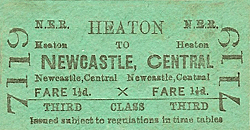 There were two island platforms approximately 210 yd in length. The north-west one (platforms 1 and 2) served down and up main lines respectively, and the south-east one (platforms 3 and 4) served down and up suburban (Coast Circle) trains. The outer down line swerved around platform 1 making a speed restriction for main line trains necessary. There were two island platforms approximately 210 yd in length. The north-west one (platforms 1 and 2) served down and up main lines respectively, and the south-east one (platforms 3 and 4) served down and up suburban (Coast Circle) trains. The outer down line swerved around platform 1 making a speed restriction for main line trains necessary.
A wooden building with a ridged roof line, slung across all four tracks about midway along the platforms, contained booking and waiting facilities. There was some decoration to the gable ends, and an ornate lamp bracket was attached to the south-east entrance. Inside were a general and a first class waiting room, another for 3rd class ladies, and the booking hall. An additional suburban booking office was located at an entrance to platforms 3 and 4 on Heaton Road.
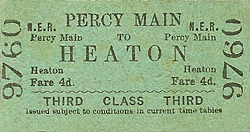 From the main building ramps led down to the platforms which were sheltered by generous roofs. Each roof extended north-eastwards for about 90 yd from the over-track building. The roofs were supported by two rows of cast iron columns, with brackets bearing a Star of David motif. The columns carried wrought iron lattice girders which acted as purlins. The roof had a skirt of slated boarding. Above the purlins was a glazed skylight raised on a shallow ventilator. In the absence of waiting rooms on the platforms there were benches protected by tall glazed screens. (Detail from Fawcett, 2005) From the main building ramps led down to the platforms which were sheltered by generous roofs. Each roof extended north-eastwards for about 90 yd from the over-track building. The roofs were supported by two rows of cast iron columns, with brackets bearing a Star of David motif. The columns carried wrought iron lattice girders which acted as purlins. The roof had a skirt of slated boarding. Above the purlins was a glazed skylight raised on a shallow ventilator. In the absence of waiting rooms on the platforms there were benches protected by tall glazed screens. (Detail from Fawcett, 2005)
The station remained essentially unchanged until 1974 when the platform roofing was removed, and a simple ‘bus shelter’ installed on platforms 3 and 4. No shelter was supplied on the main line platforms. The main over-track building survived the carnage.
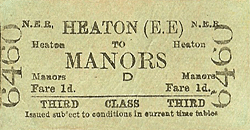 LNER wooden nameboards of a design probably unique to the ‘Coast Circle’ stations were installed c1933. These were shaped to incorporate the early-LNER diamond motif, and they survived until at least 1959. At Heaton, as all other Coast Circle stations, BR(NE) vitreous enamel nameboards, with black edged lettering. replaced the earlier signage. Until 1974 LNER electric lamps with mint imperial shades were suspended from the platform roofs, accompanied by LNER nameplates. BR totem signs were never installed. In the modernization of 1974 tall electric lamps appeared, and soon after corporate identity nameboards were added and the NE nameboards removed. The station was demolished within a few months of closure. LNER wooden nameboards of a design probably unique to the ‘Coast Circle’ stations were installed c1933. These were shaped to incorporate the early-LNER diamond motif, and they survived until at least 1959. At Heaton, as all other Coast Circle stations, BR(NE) vitreous enamel nameboards, with black edged lettering. replaced the earlier signage. Until 1974 LNER electric lamps with mint imperial shades were suspended from the platform roofs, accompanied by LNER nameplates. BR totem signs were never installed. In the modernization of 1974 tall electric lamps appeared, and soon after corporate identity nameboards were added and the NE nameboards removed. The station was demolished within a few months of closure.
BRIEF HISTORY OF THE RAILWAYS THROUGH HEATON
After unsuccessful schemes in 1828 and 1833 an Act of Parliament on 21 June 1836 authorized a route from Pilgrim Street, Newcastle, to North Shields quay. The Newcastle & North Shields Railway opened on 20 June 1839. The intended Newcastle terminus was never built, and the temporary Carliol Square station sufficed until 1850 when Newcastle Central station opened.
 The Newcastle & Berwick Railway (later York, Newcastle & Berwick) was backed by the ‘Railway King’ George Hudson, with technical support from George Stephenson. This ambitious company, whose scheme received the Royal Assent on 21 July 1845, absorbed the Newcastle & North Shields in July 1846, thereby acquiring the route from Newcastle (Carliol Square). The North Shields line was used for about 1½ miles to Heaton Junction, where the Berwick route swept away from the existing line on a broad curve. The N&B opened from Heaton to Morpeth on 1 March 1847. Further north the Chathill – Tweedmouth section opened on 29 March 1847, followed by Morpeth – Chathill on 1 July 1847. Passenger trains were extended across the Royal Border Bridge into Berwick on 30 August 1850; on the same day Carliol Square station was closed and trains were diverted to the newly-opened Newcastle Central. The Newcastle & Berwick Railway (later York, Newcastle & Berwick) was backed by the ‘Railway King’ George Hudson, with technical support from George Stephenson. This ambitious company, whose scheme received the Royal Assent on 21 July 1845, absorbed the Newcastle & North Shields in July 1846, thereby acquiring the route from Newcastle (Carliol Square). The North Shields line was used for about 1½ miles to Heaton Junction, where the Berwick route swept away from the existing line on a broad curve. The N&B opened from Heaton to Morpeth on 1 March 1847. Further north the Chathill – Tweedmouth section opened on 29 March 1847, followed by Morpeth – Chathill on 1 July 1847. Passenger trains were extended across the Royal Border Bridge into Berwick on 30 August 1850; on the same day Carliol Square station was closed and trains were diverted to the newly-opened Newcastle Central.
 The lines through Heaton were electrified in 1904 (including the East Coast main line as far as Benton East and West junctions) and the suburban route developed in stages into the ‘Coast Circle’ service (Newcastle Central – Wallsend – Tynemouth – Whitley Bay – Benton – Newcastle Central) which began in 1917. Electric trains provided an intensive service until their replacement with diesel multiple units in 1967. Main line express trains did not stop at Heaton, and, after World War II, ‘local’ stopping services were few. The lines through Heaton were electrified in 1904 (including the East Coast main line as far as Benton East and West junctions) and the suburban route developed in stages into the ‘Coast Circle’ service (Newcastle Central – Wallsend – Tynemouth – Whitley Bay – Benton – Newcastle Central) which began in 1917. Electric trains provided an intensive service until their replacement with diesel multiple units in 1967. Main line express trains did not stop at Heaton, and, after World War II, ‘local’ stopping services were few.
 On 11 August 1980, in preparation for the extension of the Tyneside Metro light-rail system, trains on the suburban route from Newcastle to Tynemouth via Heaton and Wallsend were withdrawn, and stations from Heaton to North Shields inclusive were closed. Walker Gate, Wallsend, Howdon-on-Tyne, Percy Main and North Shields were reconstructed and reopened on 14 November 1982 as part of the Metro, by which date Heaton station had been demolished. A new Metro route was constructed between Newcastle Central (underground station) and Heaton Junction, avoiding Heaton station, with new stations at Manors (underground), and at Byker and Chillingham Road, which made Heaton redundant. On 11 August 1980, in preparation for the extension of the Tyneside Metro light-rail system, trains on the suburban route from Newcastle to Tynemouth via Heaton and Wallsend were withdrawn, and stations from Heaton to North Shields inclusive were closed. Walker Gate, Wallsend, Howdon-on-Tyne, Percy Main and North Shields were reconstructed and reopened on 14 November 1982 as part of the Metro, by which date Heaton station had been demolished. A new Metro route was constructed between Newcastle Central (underground station) and Heaton Junction, avoiding Heaton station, with new stations at Manors (underground), and at Byker and Chillingham Road, which made Heaton redundant.
Click here for a brief history of the East Coast Main Line
in Northumberland.
Click here for 37 photos of Heaton station in 1974
Sources:
Further reading: Young, Alan Suburban Railways of Tyneside (Pub: Martin Bairstow 1999). Young, Alan Railways of Northumberland (Pub: Martin Bairstow 2003). Tickets from Michael Stewart. Other web sites: Northumbrian Railways
See other ECML stations:Tweedmouth, Scremerston, Goswick, Beal, Smeafield, Crag Mill, Belford, Lucker,
Newham, Fallodon, Little Mill, Longhoughton, Lesbury, Warkworth, Longhirst, Ashington Colliery Junction, Morpeth, Stannington, Plessey, Annitsford (1st), Annitsford (2nd), Killingworth, Forest Hall, Heaton (1st), Durham, Croft Spa, Eryholme, Otterington, Alne & Tollerton
|

old1.jpg)

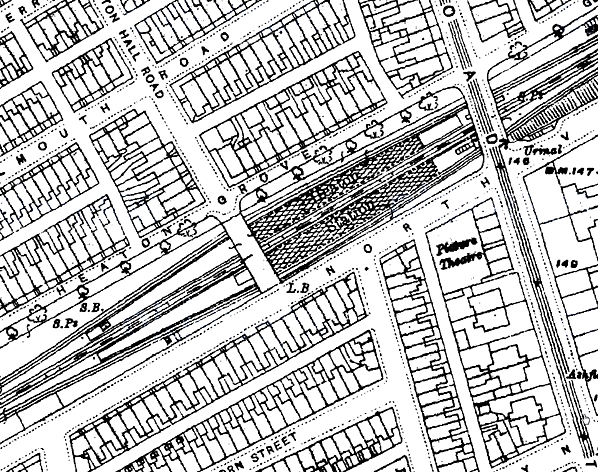
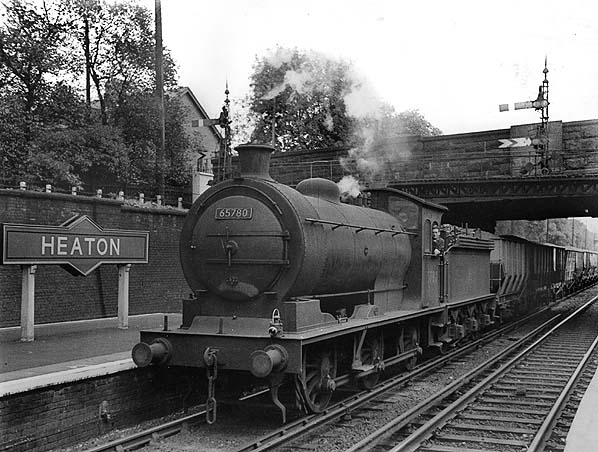
1.jpg)
11.jpg)
6.jpg)
7.jpg)
15.jpg)
14.jpg)
 There were two island platforms approximately 210 yd in length. The north-west one (platforms 1 and 2) served down and up main lines respectively, and the south-east one (platforms 3 and 4) served down and up suburban (Coast Circle) trains. The outer down line swerved around platform 1 making a speed restriction for main line trains necessary.
There were two island platforms approximately 210 yd in length. The north-west one (platforms 1 and 2) served down and up main lines respectively, and the south-east one (platforms 3 and 4) served down and up suburban (Coast Circle) trains. The outer down line swerved around platform 1 making a speed restriction for main line trains necessary. From the main building ramps led down to the platforms which were sheltered by generous roofs. Each roof extended north-eastwards for about 90 yd from the over-track building. The roofs were supported by two rows of cast iron columns, with brackets bearing a Star of David motif. The columns carried wrought iron lattice girders which acted as purlins. The roof had a skirt of slated boarding. Above the purlins was a glazed skylight raised on a shallow ventilator. In the absence of waiting rooms on the platforms there were benches protected by tall glazed screens. (Detail from Fawcett, 2005)
From the main building ramps led down to the platforms which were sheltered by generous roofs. Each roof extended north-eastwards for about 90 yd from the over-track building. The roofs were supported by two rows of cast iron columns, with brackets bearing a Star of David motif. The columns carried wrought iron lattice girders which acted as purlins. The roof had a skirt of slated boarding. Above the purlins was a glazed skylight raised on a shallow ventilator. In the absence of waiting rooms on the platforms there were benches protected by tall glazed screens. (Detail from Fawcett, 2005)
 LNER wooden nameboards of a design probably unique to the ‘Coast Circle’ stations were installed c1933. These were shaped to incorporate the early-LNER diamond motif, and they survived until at least 1959. At Heaton, as all other Coast Circle stations, BR(NE) vitreous enamel nameboards, with black edged lettering. replaced the earlier signage. Until 1974 LNER electric lamps with mint imperial shades were suspended from the platform roofs, accompanied by LNER nameplates. BR totem signs were never installed. In the modernization of 1974 tall electric lamps appeared, and soon after corporate identity nameboards were added and the NE nameboards removed. The station was demolished within a few months of closure.
LNER wooden nameboards of a design probably unique to the ‘Coast Circle’ stations were installed c1933. These were shaped to incorporate the early-LNER diamond motif, and they survived until at least 1959. At Heaton, as all other Coast Circle stations, BR(NE) vitreous enamel nameboards, with black edged lettering. replaced the earlier signage. Until 1974 LNER electric lamps with mint imperial shades were suspended from the platform roofs, accompanied by LNER nameplates. BR totem signs were never installed. In the modernization of 1974 tall electric lamps appeared, and soon after corporate identity nameboards were added and the NE nameboards removed. The station was demolished within a few months of closure.

 The Newcastle & Berwick Railway (later York, Newcastle & Berwick) was backed by the ‘Railway King’ George Hudson, with technical support from George Stephenson. This ambitious company, whose scheme received the Royal Assent on 21 July 1845, absorbed the Newcastle & North Shields in July 1846, thereby acquiring the route from Newcastle (Carliol Square). The North Shields line was used for about 1½ miles to Heaton Junction, where the Berwick route swept away from the existing line on a broad curve. The N&B opened from Heaton to Morpeth on 1 March 1847. Further north the Chathill – Tweedmouth section opened on 29 March 1847, followed by Morpeth – Chathill on 1 July 1847. Passenger trains were extended across the Royal Border Bridge into Berwick on 30 August 1850; on the same day Carliol Square station was closed and trains were diverted to the newly-opened Newcastle Central.
The Newcastle & Berwick Railway (later York, Newcastle & Berwick) was backed by the ‘Railway King’ George Hudson, with technical support from George Stephenson. This ambitious company, whose scheme received the Royal Assent on 21 July 1845, absorbed the Newcastle & North Shields in July 1846, thereby acquiring the route from Newcastle (Carliol Square). The North Shields line was used for about 1½ miles to Heaton Junction, where the Berwick route swept away from the existing line on a broad curve. The N&B opened from Heaton to Morpeth on 1 March 1847. Further north the Chathill – Tweedmouth section opened on 29 March 1847, followed by Morpeth – Chathill on 1 July 1847. Passenger trains were extended across the Royal Border Bridge into Berwick on 30 August 1850; on the same day Carliol Square station was closed and trains were diverted to the newly-opened Newcastle Central.
 The lines through Heaton were electrified in 1904 (including the East Coast main line as far as Benton East and West junctions) and the suburban route developed in stages into the ‘Coast Circle’ service (Newcastle Central – Wallsend – Tynemouth – Whitley Bay – Benton – Newcastle Central) which began in 1917. Electric trains provided an intensive service until their replacement with diesel multiple units in 1967. Main line express trains did not stop at Heaton, and, after World War II, ‘local’ stopping services were few.
The lines through Heaton were electrified in 1904 (including the East Coast main line as far as Benton East and West junctions) and the suburban route developed in stages into the ‘Coast Circle’ service (Newcastle Central – Wallsend – Tynemouth – Whitley Bay – Benton – Newcastle Central) which began in 1917. Electric trains provided an intensive service until their replacement with diesel multiple units in 1967. Main line express trains did not stop at Heaton, and, after World War II, ‘local’ stopping services were few.
 On 11 August 1980, in preparation for the extension of the Tyneside Metro light-rail system, trains on the suburban route from Newcastle to Tynemouth via Heaton and Wallsend were withdrawn, and stations from Heaton to North Shields inclusive were closed. Walker Gate, Wallsend, Howdon-on-Tyne, Percy Main and North Shields were reconstructed and reopened on 14 November 1982 as part of the Metro, by which date Heaton station had been demolished. A new Metro route was constructed between Newcastle Central (underground station) and Heaton Junction, avoiding Heaton station, with new stations at Manors (underground), and at Byker and Chillingham Road, which made Heaton redundant.
On 11 August 1980, in preparation for the extension of the Tyneside Metro light-rail system, trains on the suburban route from Newcastle to Tynemouth via Heaton and Wallsend were withdrawn, and stations from Heaton to North Shields inclusive were closed. Walker Gate, Wallsend, Howdon-on-Tyne, Percy Main and North Shields were reconstructed and reopened on 14 November 1982 as part of the Metro, by which date Heaton station had been demolished. A new Metro route was constructed between Newcastle Central (underground station) and Heaton Junction, avoiding Heaton station, with new stations at Manors (underground), and at Byker and Chillingham Road, which made Heaton redundant. old_thumb3.jpg)
thumb2.jpg)
thumb4.jpg)
thumb3.jpg)
thumb5.jpg)
thumb8.jpg)
thumb9.jpg)
thumb10.jpg)
thumb13.jpg)
thumb12.jpg)
thumb16.jpg)
thumb17.jpg)
thumb18.jpg)
thumb19.jpg)

 Home Page
Home Page